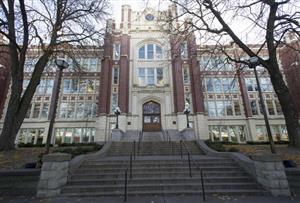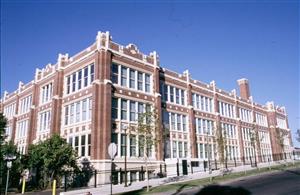- Lewis & Clark High School
- LC History
The Lewis & Clark Story
-
Watch LC Videos: The Tradition Continues • History in the Making
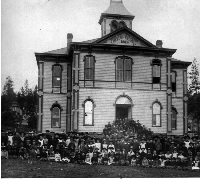
The second public school built in Spokane was constructed in 1883 at 4th and Stevens on the present site of Lewis and Clark High School. This four-room, wooden frame building was named Central School. Two additional rooms were added as the student body grew. The school contained all grade levels for the area. Records show that in 1887, the teacher pay was $65 per month and for custodians, $50 per month. The building was in service for approximately seven years until the school could no longer accommodate the growing student body.
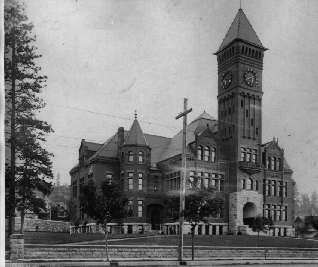 A $250,000 school bond was authorized by the voters in July, 1890 for the construction of a high school and four elementary schools. Central School was moved to 5th and Washington to make way for the new high school. The new building was completed on the site of the present Lewis and Clark High School in May 1891 at a cost of $110,000. It was called Central High School until September 1908. It was then referred to as South Central High School when the new North Central High School was opened in September 1908.
A $250,000 school bond was authorized by the voters in July, 1890 for the construction of a high school and four elementary schools. Central School was moved to 5th and Washington to make way for the new high school. The new building was completed on the site of the present Lewis and Clark High School in May 1891 at a cost of $110,000. It was called Central High School until September 1908. It was then referred to as South Central High School when the new North Central High School was opened in September 1908. Shortly after 6:00am on Tuesday, June 21, 1910, fire broke out in South Central High School. The spectacular blaze destroyed the interior of the school but left the remains of the exterior walls standing. While the fire consumed the school, the memorial fountain in front of the school, presented by the class of 1910, continued to spout water. Student records and some of the school's athletic trophies were saved, but all of the school's expensive classroom equipment, contents of the library, and memorabilia from graduating classes lining the halls was lost. It is thought the fire started in the auditorium, but the cause is unknown.
Shortly after 6:00am on Tuesday, June 21, 1910, fire broke out in South Central High School. The spectacular blaze destroyed the interior of the school but left the remains of the exterior walls standing. While the fire consumed the school, the memorial fountain in front of the school, presented by the class of 1910, continued to spout water. Student records and some of the school's athletic trophies were saved, but all of the school's expensive classroom equipment, contents of the library, and memorabilia from graduating classes lining the halls was lost. It is thought the fire started in the auditorium, but the cause is unknown.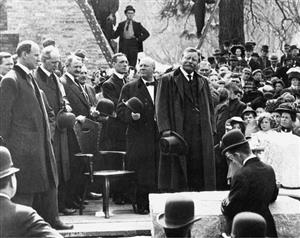 Plans to replace South Central High School began immediately. The architect selected was L.L. Rand, who also designed the Spokane Masonic Temple and the Carlyle Hotel. The construction contract was awarded in January, 1911 and the building permit issued in February, 1911. The cornerstone was laid by former President Teddy Roosevelt in the presence of a large crowd of people on April 8, 1911.
Plans to replace South Central High School began immediately. The architect selected was L.L. Rand, who also designed the Spokane Masonic Temple and the Carlyle Hotel. The construction contract was awarded in January, 1911 and the building permit issued in February, 1911. The cornerstone was laid by former President Teddy Roosevelt in the presence of a large crowd of people on April 8, 1911.The first major problem facing the school board after the fire was how to accommodate the South Central students when school opened in September, 1910. A proposal was made to send all South Central students to school with North Central students. Various problems arose, including that of transportation, but the Board finally decided to send junior and seniors of both schools to North Central in the morning and underclassmen in the afternoons. Graduates would receive diplomas stating that they had graduated from their respective schools, North or South Central.
When school started in September, the two principals expected that trouble might erupt but this never occurred. To instill joint school spirit, Principal Henry Hart of South Central and Principal R. T. Hargreaves of North Central, flew the orange and black banner of South Central alongside the red and black banner of North Central with a banner of blue and white, symbolizing the joint school colors, flying above. For a year and a half, the two schools worked together in studies, athletics and other school activities as "Spokane High School." Combined teams won the championship in baseball, basketball, track and oratory; the football team did not do too well the first season, but defeated all except Wenatchee the following year.
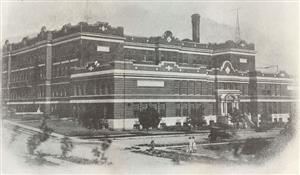 Students continued to attend classes at North Central while work progressed on the new school. It was hoped that the school would be ready for opening in the fall of 1911, but problems in construction and strikes by workers delayed the opening until April, 1912. Meanwhile, the Spokane Daily Chronicle encouraged readers to enter a contest to suggest names for the new high school. North Central Principal Richard T. Hargreaves suggested the names of Lewis and Clark, using one name for each high school, North and South Central. The school board settled for naming the south side school Lewis and Clark.
Students continued to attend classes at North Central while work progressed on the new school. It was hoped that the school would be ready for opening in the fall of 1911, but problems in construction and strikes by workers delayed the opening until April, 1912. Meanwhile, the Spokane Daily Chronicle encouraged readers to enter a contest to suggest names for the new high school. North Central Principal Richard T. Hargreaves suggested the names of Lewis and Clark, using one name for each high school, North and South Central. The school board settled for naming the south side school Lewis and Clark.Alumni and students of Spokane/South Central high school were invited to attend the three day grand opening of the magnificent new Tudor-Gothic style school which began on the evening of April 1, 1912, with a concert and reception in the new auditorium. Principal Henry Hart, assisted by the oldest member of the faculty, Mrs. Olive B. Jones, planned the entire event. Tuesday, April 2, included a tour of the new building and reunion gatherings of the various classes from years past, followed by an evening program and reception. The formal dedication of Lewis and Clark High School took place on Wednesday afternoon, April 3, 1912. Everyone who toured the imposing brick building trimmed with terra cotta was impressed with its main entry sheathed in marble and the wide interior hallways covered with marble terrazzo. Called the pride of the city and superior to any other high school west of the Mississippi, the school covered almost the entire block. The total cost of construction for the new Lewis and Clark was $660,000.
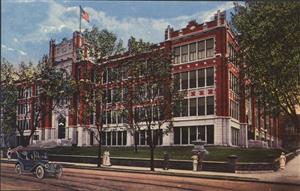
In May, 1912, Lewis and Clark High School published the first issue of The Lewis and Clark Journal, a title the award-winning publication has retained to the present day. This evolved from the earlier Orange and Black that was first issued by Spokane High School. During the time the two high schools were combined after the 1910 fire, their joint publication was called The Blue and White. The Journal, published monthly during the school year, originally carried articles about school life and each semester featured photographs and information about graduating seniors. By 1920, The Tiger became the annual school publication covering the school year.
The first graduating class of the new school gave portraits of Lewis and Clark. Over the years the tradition continued, with classes donating art works that line the halls of the school. Careful restoration of the art has been done while the new addition is being built, to ensure that the renovated halls will once again be a showcase of the school's valuable art collection. Principal Hart encouraged classes from 1921 to 1925 to raise money to purchase an Austin pipe organ that was installed in the auditorium. In 1979, students and faculty members raised money to restore the organ. Hart also persuaded each graduating class from 1924 to 1937 to donate their book deposits to help purchase a play field for the school. With assistance from alumni, Hart Field, located on the south hill between 33rd and 37th west of Grand Boulevard and named for Principal Hart, was purchased. It was understood at the time of the purchase that sometime in the future Lewis and Clark High school might be moved to this site; however, the recent decision to retain the present school and build an addition at its current site has finally laid that idea to rest.
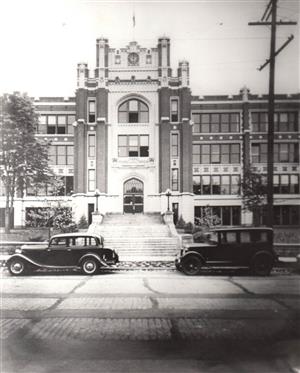
Lewis and Clark had become one of the largest high schools in Washington State by 1964 and needed more space. The addition of a field house, opened in 1965, was a major accomplishment for Lewis and Clark's athletic program. The building was named for E. L. "Squinty" Hunter, the most successful basketball coach in the history of the school and athletic director for 39 years.
The Administration Building/Annex adjacent to the high school, was designed by architect Rand and constructed in 1908 to house the offices of School District #81 and a gymnasium for the high school. In 1917, the building was expanded to offer more space for the school's programs. For many years, school dances were held in the building.
On the main campus, the closing of Howard Street in 1980 was the dream of Spokane Hutchison, LC English teacher and ASB advisor. "Mrs. Hutch" as she was fondly called, spent 10 years in her quest to create a campus for Lewis and Clark students. The area features the stone fountain donated by the Class of 1910, the same fountain that spouted water while old South Central burned.
During a 1995 parent meeting, community members expressed concern about the physical condition of the school. A parent study committee was formed and charged with determining whether to renovate Lewis and Clark, or build a new high school at Hart Field, so some other site. The overwhelming recommendation was to restore Lewis and Clark to its original beauty.
In 1998, Spokane voters approved a $75 million bond for improvement of schools city-wide. Of that, $27 million was earmarked to renovate and expand the nearly century-old downtown landmark. The state of Washington also contributed an additional $13 million to the project.
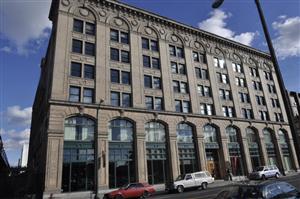 During the two-year project, students attended classes in the renovated Holley-Mason Building (located two blocks down Howard Street).
During the two-year project, students attended classes in the renovated Holley-Mason Building (located two blocks down Howard Street).The "Squinty Hunter" Field House and the administration building were demolished to make way for the renovation and expansion. The archway remains to the original administration building.
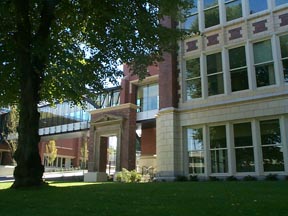
In 2001, Lewis and Clark officially reopened its doors to students and staff. A weekend gala event was organized by Spokane Public Schools to allow the citizens of Spokane to visit the restored treasure. Watch "Lewis & Clark High School -- The Tradition Contines" here.
No one who attended Lewis and Clark will forget the many outstanding principals and teachers who influenced their lives and, if asked, each graduating class could list several names. Some became legends, either for their deeds or for their expertise in their teaching fields. To single out one name among the many who have contributed so much to generations of Lewis and Clark graduates is too difficult.
Lewis and Clark was selected one of the 100 best schools in the United States by state superintendents and prominent educators, a fact that was published in Look magazine, October 1, 1946. In 1925, an article in Colliers magazine said, "When Henry Hart became principal of Lewis and Clark High School, two ideas dominated him…one that education must be given beauty and color and interest, the other that pupils must get the sense of owning. These ideas he has worked out. Boys and girls seem to love the school…it's theirs…and the very building breathes ardor and happiness." Today that feeling is still true, the school is loved by those who attend it and by those who graduated from it. Tiger pride is intact.
On Nov. 30, 2001, Lewis and Clark was listed on the National Register of Historic Places and in 2011, it was featured in a video highlighting Washington's historic sites.
